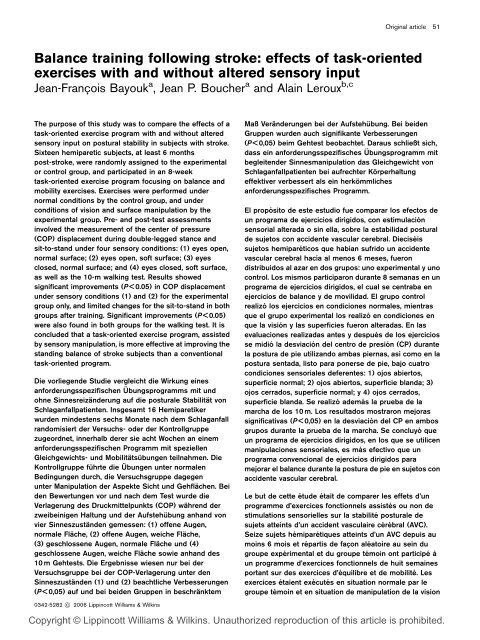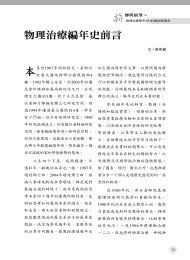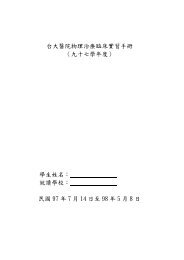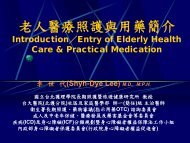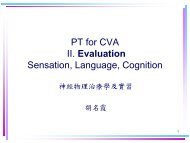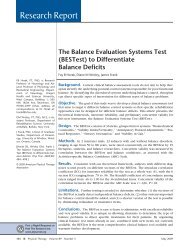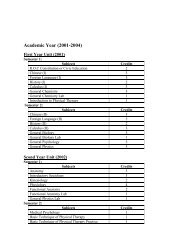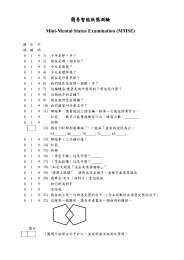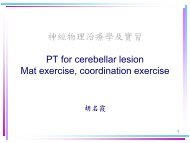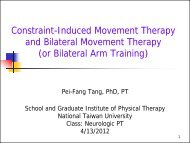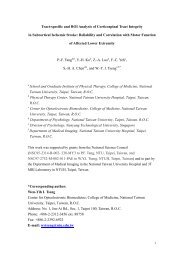Balance training following stroke: effects of task-oriented exercises ...
Balance training following stroke: effects of task-oriented exercises ...
Balance training following stroke: effects of task-oriented exercises ...
You also want an ePaper? Increase the reach of your titles
YUMPU automatically turns print PDFs into web optimized ePapers that Google loves.
Original article 51<br />
<strong>Balance</strong> <strong>training</strong> <strong>following</strong> <strong>stroke</strong>: <strong>effects</strong> <strong>of</strong> <strong>task</strong>-<strong>oriented</strong><br />
<strong>exercises</strong> with and without altered sensory input<br />
Jean-François Bayouk a , Jean P. Boucher a and Alain Leroux b,c<br />
The purpose <strong>of</strong> this study was to compare the <strong>effects</strong> <strong>of</strong> a<br />
<strong>task</strong>-<strong>oriented</strong> exercise program with and without altered<br />
sensory input on postural stability in subjects with <strong>stroke</strong>.<br />
Sixteen hemiparetic subjects, at least 6 months<br />
post-<strong>stroke</strong>, were randomly assigned to the experimental<br />
or control group, and participated in an 8-week<br />
<strong>task</strong>-<strong>oriented</strong> exercise program focusing on balance and<br />
mobility <strong>exercises</strong>. Exercises were performed under<br />
normal conditions by the control group, and under<br />
conditions <strong>of</strong> vision and surface manipulation by the<br />
experimental group. Pre- and post-test assessments<br />
involved the measurement <strong>of</strong> the center <strong>of</strong> pressure<br />
(COP) displacement during double-legged stance and<br />
sit-to-stand under four sensory conditions: (1) eyes open,<br />
normal surface; (2) eyes open, s<strong>of</strong>t surface; (3) eyes<br />
closed, normal surface; and (4) eyes closed, s<strong>of</strong>t surface,<br />
as well as the 10-m walking test. Results showed<br />
significant improvements (P < 0.05) in COP displacement<br />
under sensory conditions (1) and (2) for the experimental<br />
group only, and limited changes for the sit-to-stand in both<br />
groups after <strong>training</strong>. Significant improvements (P < 0.05)<br />
were also found in both groups for the walking test. It is<br />
concluded that a <strong>task</strong>-<strong>oriented</strong> exercise program, assisted<br />
by sensory manipulation, is more effective at improving the<br />
standing balance <strong>of</strong> <strong>stroke</strong> subjects than a conventional<br />
<strong>task</strong>-<strong>oriented</strong> program.<br />
Die vorliegende Studie vergleicht die Wirkung eines<br />
anforderungsspezifischen Übungsprogramms mit und<br />
ohne Sinnesreizänderung auf die posturale Stabilität von<br />
Schlaganfallpatienten. Insgesamt 16 Hemiparetiker<br />
wurden mindestens sechs Monate nach dem Schlaganfall<br />
randomisiert der Versuchs- oder der Kontrollgruppe<br />
zugeordnet, innerhalb derer sie acht Wochen an einem<br />
anforderungsspezifischen Programm mit speziellen<br />
Gleichgewichts- und Mobilitätsübungen teilnahmen. Die<br />
Kontrollgruppe führte die Übungen unter normalen<br />
Bedingungen durch, die Versuchsgruppe dagegen<br />
unter Manipulation der Aspekte Sicht und Gehflächen. Bei<br />
den Bewertungen vor und nach dem Test wurde die<br />
Verlagerung des Druckmittelpunkts (COP) während der<br />
zweibeinigen Haltung und der Aufstehübung anhand von<br />
vier Sinneszuständen gemessen: (1) <strong>of</strong>fene Augen,<br />
normale Fläche, (2) <strong>of</strong>fene Augen, weiche Fläche,<br />
(3) geschlossene Augen, normale Fläche und (4)<br />
geschlossene Augen, weiche Fläche sowie anhand des<br />
10 m Gehtests. Die Ergebnisse wiesen nur bei der<br />
Versuchsgruppe bei der COP-Verlagerung unter den<br />
Sinneszuständen (1) und (2) beachtliche Verbesserungen<br />
(P < 0,05) auf und bei beiden Gruppen in beschränktem<br />
Maß Veränderungen bei der Aufstehübung. Bei beiden<br />
Gruppen wurden auch signifikante Verbesserungen<br />
(P < 0,05) beim Gehtest beobachtet. Daraus schließt sich,<br />
dass ein anforderungsspezifisches Übungsprogramm mit<br />
begleitender Sinnesmanipulation das Gleichgewicht von<br />
Schlaganfallpatienten bei aufrechter Körperhaltung<br />
effektiver verbessert als ein herkömmliches<br />
anforderungsspezifisches Programm.<br />
El propósito de este estudio fue comparar los efectos de<br />
un programa de ejercicios dirigidos, con estimulación<br />
sensorial alterada o sin ella, sobre la estabilidad postural<br />
de sujetos con accidente vascular cerebral. Dieciséis<br />
sujetos hemiparéticos que habían sufrido un accidente<br />
vascular cerebral hacía al menos 6 meses, fueron<br />
distribuidos al azar en dos grupos: uno experimental y uno<br />
control. Los mismos participaron durante 8 semanas en un<br />
programa de ejercicios dirigidos, el cual se centraba en<br />
ejercicios de balance y de movilidad. El grupo control<br />
realizó los ejercicios en condiciones normales, mientras<br />
que el grupo experimental los realizó en condiciones en<br />
que la visión y las superficies fueron alteradas. En las<br />
evaluaciones realizadas antes y después de los ejercicios<br />
se midió la desviación del centro de presión (CP) durante<br />
la postura de pie utilizando ambas piernas, así como en la<br />
postura sentada, listo para ponerse de pie, bajo cuatro<br />
condiciones sensoriales deferentes: 1) ojos abiertos,<br />
superficie normal; 2) ojos abiertos, superficie blanda; 3)<br />
ojos cerrados, superficie normal; y 4) ojos cerrados,<br />
superficie blanda. Se realizó además la prueba de la<br />
marcha de los 10 m. Los resultados mostraron mejoras<br />
significativas (P < 0,05) en la desviación del CP en ambos<br />
grupos durante la prueba de la marcha. Se concluyó que<br />
un programa de ejercicios dirigidos, en los que se utilicen<br />
manipulaciones sensoriales, es más efectivo que un<br />
programa convencional de ejercicios dirigidos para<br />
mejorar el balance durante la postura de pie en sujetos con<br />
accidente vascular cerebral.<br />
Le but de cette étude était de comparer les effets d’un<br />
programme d’exercices fonctionnels assistés ou non de<br />
stimulations sensorielles sur la stabilité posturale de<br />
sujets atteints d’un accident vasculaire cérébral (AVC).<br />
Seize sujets hémiparétiques atteints d’un AVC depuis au<br />
moins 6 mois et répartis de façon aléatoire au sein du<br />
groupe expérimental et du groupe témoin ont participé à<br />
un programme d’exercices fonctionnels de huit semaines<br />
portant sur des exercices d’équilibre et de mobilité. Les<br />
exercices étaient exécutés en situation normale par le<br />
groupe témoin et en situation de manipulation de la vision<br />
0342-5282 c 2006 Lippincott Williams & Wilkins<br />
Copyright © Lippincott Williams & Wilkins. Unauthorized reproduction <strong>of</strong> this article is prohibited.
52 International Journal <strong>of</strong> Rehabilitation Research 2006, Vol 29 No 1<br />
et de la surface de support par le groupe expérimental. Les<br />
évaluations pré et post exercices ont été effectuées à l’aide<br />
de la mesure du déplacement du centre de pression (CP)<br />
lors du maintien de la position debout en appui bipodal et<br />
du transfert assis-debout selon les quatre conditions<br />
sensorielles suivantes: yeux ouverts, surface normale (1);<br />
yeux ouverts, surface moelleuse (2); yeux fermés, surface<br />
normale (3); yeux fermés, surface moelleuse (4). Le test de<br />
marchede10mètres a aussi été inclus dans l’évaluation.<br />
Les résultats ont démontré une amélioration significative<br />
(P < 0.05) du déplacement du CP dans les conditions 1 et 2<br />
pour le groupe expérimental seulement ainsi que des<br />
changements limités pour le transfert assis-debout chez<br />
les deux groupes de sujets à la suite de l’entraînement.<br />
Une amélioration significative (P < 0.05) a été observée au<br />
niveau du test de marche chez les deux groupes de sujets.<br />
Cette étude a démontré qu’un programme d’exercices<br />
fonctionnels assistés de stimulations sensorielles est plus<br />
efficace pour l’amélioration du maintien de l’équilibre en<br />
position debout chez les sujets atteints d’un AVC qu’un<br />
programme d’exercices fonctionnels conventionnnel.<br />
International Journal <strong>of</strong> Rehabilitation Research 29:51–59<br />
c 2006 Lippincott Williams & Wilkins.<br />
International Journal <strong>of</strong> Rehabilitation Research 2006, 29:51–59<br />
Keywords: exercise, <strong>stroke</strong>, multisensory <strong>training</strong>, hemiparesis, hemiplegia,<br />
balance, postural stability<br />
a Department <strong>of</strong> Kinanthropology, University <strong>of</strong> Quebec in Montréal, Montréal,<br />
Canada, b Department <strong>of</strong> Exercise Science, Concordia University, Montréal,<br />
Canada and c Centre de Recherche Interdisciplinaire en Réadaptation du<br />
Montréal Métropolitan-Site, Constance-Lethbridge Rehabilitation Centre,<br />
Montreal, Canada.<br />
Correspondence and requests for reprints to Alain Leroux, Department <strong>of</strong><br />
Exercise Science, Concordia University, 7141 Sherbrooke West, Montréal<br />
(Quebec), Canada H4B 1R6.<br />
Tel: + 1 514 84803326; fax: + 1 514 848 8681;<br />
e-mail: alerou@alcor.concordia.ca<br />
Sponsorship: Funding for this study was provided by the Faculty <strong>of</strong> Arts and<br />
Science <strong>of</strong> Concordia University (no. NS2001-001).<br />
Received 2 May 2005 Accepted 11 July 2005<br />
Introduction<br />
<strong>Balance</strong> impairment is important to consider after <strong>stroke</strong><br />
since the number <strong>of</strong> falls can be as high as five per year in<br />
the first year post-lesion (Nyberg and Gustafson, 1995).<br />
These falls can further lead to pathological events (e.g.<br />
hip fractures), and additional declines in function and<br />
disability status (Grisso et al., 1991). The decreased<br />
ability to maintain static and dynamic balance after <strong>stroke</strong><br />
could be related to the inability to select reliable sensory<br />
information (visual, vestibular and somatosensory systems)<br />
in order to produce the proper motor action<br />
necessary to maintain postural stability (Shumway-Cook<br />
et al., 1988; Di Fabio and Badke, 1991; Bonan et al., 2004a).<br />
It was found, for instance, that <strong>stroke</strong> subjects having<br />
impaired ankle proprioception exhibited a significant<br />
increase in postural sway as compared to <strong>stroke</strong> subjects<br />
showing intact proprioception during double-legged<br />
stance (Niam et al., 1999). Furthermore, when sensory<br />
inputs from the visual, vestibular and somatosensory<br />
systems were manipulated, <strong>stroke</strong> subjects exhibited<br />
greater postural instability than healthy subjects (Di<br />
Fabio and Badke, 1991; Bonan et al., 2004a).<br />
Exercise interventions, in the form <strong>of</strong> <strong>task</strong>-<strong>oriented</strong><br />
exercise programs, are now recognized as a new strategy<br />
to improve the functional status <strong>of</strong> chronic <strong>stroke</strong><br />
individuals (Dean et al., 2000; Eng et al., 2003; Salbach<br />
et al., 2004; Leroux, 2005) Hence, <strong>following</strong> several weeks<br />
<strong>of</strong> functional <strong>training</strong>, hemiparetic subjects, secondary to<br />
<strong>stroke</strong>, have shown significant improvements in functional<br />
mobility (Eng et al., 2003; Leroux, 2005), walking<br />
speed and endurance (Dean et al., 2000; Eng et al., 2003;<br />
Salbach et al., 2004), and in clinical measures <strong>of</strong> balance<br />
(Dean et al., 2000; Eng et al., 2003; Leroux, 2005). When<br />
using laboratory measures <strong>of</strong> static and dynamic balance,<br />
<strong>task</strong>-<strong>oriented</strong> <strong>exercises</strong> did not, on the other hand, have<br />
any effect over the abnormally increased lateral sway<br />
exhibited by <strong>stroke</strong> subjects during double-legged stance<br />
and sit-to-stance <strong>task</strong>s (Leroux, 2002). Since <strong>stroke</strong><br />
subjects <strong>of</strong>ten present with somatosensory deficits<br />
(Smith et al., 1983; Di Fabio and Badke, 1990; Carr and<br />
Shepherd, 1998), the adaptation <strong>of</strong> regular <strong>exercises</strong> with<br />
the use <strong>of</strong> surface and vision manipulation to challenge<br />
balance could improve the process <strong>of</strong> somatosensory<br />
integration and have a positive effect on postural stability.<br />
This type <strong>of</strong> intervention has further shown to be<br />
effective at improving postural stability in neurologically<br />
intact elderly people (Hu and Woollacott, 1994a,b).<br />
Therefore, the main objective <strong>of</strong> this study was to<br />
compare the <strong>effects</strong> <strong>of</strong> a <strong>task</strong>-<strong>oriented</strong> exercise program<br />
with and without altered sensory input on postural<br />
stability in two groups <strong>of</strong> hemiparetic subjects secondary<br />
to <strong>stroke</strong>. A second objective was to establish the<br />
feasibility <strong>of</strong> multisensory <strong>training</strong> in older adults with<br />
<strong>stroke</strong>.<br />
Methods<br />
Subjects<br />
Sixteen hemiparetic subjects, secondary to <strong>stroke</strong>, were<br />
recruited from physiotherapy clinics, hospital centers and<br />
local <strong>stroke</strong> community groups (see Table 1). To be<br />
eligible to participate in the study, all subjects had to<br />
fulfill the <strong>following</strong> criteria: (1) be victim <strong>of</strong> a <strong>stroke</strong><br />
that resulted in hemiparesis, (2) be at least 6 months<br />
Copyright © Lippincott Williams & Wilkins. Unauthorized reproduction <strong>of</strong> this article is prohibited.
<strong>Balance</strong> <strong>training</strong> <strong>following</strong> <strong>stroke</strong> Bayouk et al. 53<br />
Table 1<br />
Pr<strong>of</strong>ile <strong>of</strong> the <strong>stroke</strong> subjects (mean ± SD)<br />
Control group (n = 8) Experimental group (n =8)<br />
Age (years) 62.0 ± 4.6 68.4 ± 7.1<br />
Time since <strong>stroke</strong> (years) 5.7 ± 6.9 7.1 ± 12.5<br />
Chedoke–McMaster <strong>stroke</strong> assessment score (/7) 4.6 ± 1.1 4.9 ± 1.25<br />
Gender (n)<br />
Male 3 6<br />
Female 5 2<br />
Hemiparetic side (n)<br />
Right 4 2<br />
Left 4 6<br />
post-<strong>stroke</strong>, (3) be fully discharged from all rehabilitation<br />
program and (4) obtain written approval from a<br />
primary care physician. Exclusion criteria were: a severe<br />
limitation that would limit the subject’s participation<br />
in the exercise program or interfere with functional<br />
assessments performed in this study. Prior to beginning<br />
the study, every subject signed an informed consent<br />
document. Ethical approval was obtained from the ethics<br />
committees <strong>of</strong> the Cummings Jewish Centre for Seniors<br />
(CJCS) and Concordia University (Montréal, Québec,<br />
Canada).<br />
Research design<br />
Stroke subjects were matched in pairs <strong>of</strong> two according to<br />
the Chedoke–McMaster Stroke Assessment stage <strong>of</strong> their<br />
mobility affected leg (Gowland et al., 1995) and randomly<br />
assigned to the experimental or control group. Each group<br />
was tested before and immediately after the end <strong>of</strong> the<br />
8-week exercise program.<br />
Exercise program<br />
Subjects from both groups participated in a 1-h (twice a<br />
week) exercise class for a period <strong>of</strong> 8 weeks. The exercise<br />
classes were held at the Wellness Centre <strong>of</strong> the CJCS<br />
(Montréal, Québec, Canada) and supervised by the same<br />
clinical exercise physiologist assisted by two intern<br />
students. Details on the Wellness Centre exercise<br />
program <strong>of</strong> the CJCS have been reported in a previous<br />
paper (Leroux, 2005). The main objective <strong>of</strong> this program<br />
is to strengthen the hemiparetic side <strong>of</strong> <strong>stroke</strong> subjects by<br />
the practice <strong>of</strong> functional <strong>exercises</strong> (Leroux, 2005).<br />
Secondary objectives include the improvement <strong>of</strong> balance,<br />
gait and coordination. In the present study,<br />
experimental and control group subjects participated in<br />
exercise sessions composed <strong>of</strong> the <strong>following</strong> <strong>task</strong>-<strong>oriented</strong><br />
<strong>exercises</strong>: (1) stepping forward, backward, and sideways<br />
on the exercise step; (2) stepping over blocks <strong>of</strong> various<br />
heights; (3) standing up from a chair, walking four steps<br />
forward, performing a bilateral stool touch and walking<br />
backwards to the chair; (4) standing up from a chair,<br />
walking four steps forward, turning to the right, stepping<br />
over the exercise step, turning to the right again and<br />
walking forwards to the chair (repeat the exercise circuit<br />
in opposite direction); (5) from a sitting position on a<br />
65-cm Swiss ball, performing a range <strong>of</strong> motion and<br />
balance <strong>exercises</strong> (forward and backward rolling <strong>of</strong> the<br />
arms; bending the trunk forward and side to side); (6)<br />
performing double-legged stance for 10 s; (7) performing<br />
tandem stance for 10 s; (8) rising from a chair without the<br />
use <strong>of</strong> the arms; (9) walking forward and backward with a<br />
tandem walking pattern (toes <strong>of</strong> one foot touching the<br />
heel <strong>of</strong> the foot in front); and (10) performing singlelegged<br />
stance for 10 s.<br />
Control group subjects performed all <strong>of</strong> the above<br />
<strong>exercises</strong> under normal conditions (i.e. with eyes open<br />
and on a hard regular surface). The level <strong>of</strong> difficulty <strong>of</strong><br />
the <strong>exercises</strong> was adjusted according to the progression <strong>of</strong><br />
each subject. The number <strong>of</strong> repetitions, the height <strong>of</strong><br />
the exercise step and the ankle weight were modified<br />
progressively. Experimental group subjects performed<br />
<strong>exercises</strong> one to five under normal conditions in the first<br />
20 min <strong>of</strong> each session. The second part <strong>of</strong> the session<br />
(30 min) aimed at improving static and dynamic balance<br />
by executing <strong>exercises</strong> while the proprioception <strong>of</strong> the<br />
feet and ankles and/or vision was manipulated. As part <strong>of</strong><br />
this multisensory <strong>training</strong>, experimental subjects performed<br />
<strong>exercises</strong> (6) to (10) under the <strong>following</strong><br />
conditions: (1) eyes open, firm surface; (2) eyes open,<br />
s<strong>of</strong>t surface; (3) eyes closed, firm surface; and (4) eyes<br />
closed, s<strong>of</strong>t surface. The s<strong>of</strong>t surface condition was<br />
performed with subjects standing on a 50 cm 62 cm<br />
foam mat (CFC free foam, 2.5 cm thick). To progress<br />
from one sensory condition to the next, the participants<br />
had to perform the exercise without any assistance and<br />
with proper form. Finally, both groups <strong>of</strong> subjects<br />
completed their session with a 10-min cool-down period<br />
where flexibility and range <strong>of</strong> motion <strong>exercises</strong> were<br />
performed in a seated position. These <strong>exercises</strong> focused<br />
on the major muscles groups involved during the class<br />
(quadriceps, hamstrings, hips, lower and upper back, and<br />
neck).<br />
Evaluation<br />
Subjects were evaluated before (pre-test) and after (posttest)<br />
the 8-week exercise program. Subjects’ postural<br />
sway was measured during the <strong>following</strong> <strong>task</strong>s: (1)<br />
double-legged stance for 10 s and (2) sit-to-stand from a<br />
chair. For the double-legged stance, subjects were<br />
instructed to maintain a steady posture and a horizontal<br />
gaze without moving the head. During the sit-to-stand<br />
test, subjects were seated on an armless chair adjusted to<br />
Copyright © Lippincott Williams & Wilkins. Unauthorized reproduction <strong>of</strong> this article is prohibited.
54 International Journal <strong>of</strong> Rehabilitation Research 2006, Vol 29 No 1<br />
their lower-leg length and were instructed to stand up at<br />
their self-paced comfortable speed without using their<br />
arms (Engardt et al., 1995; Cheng et al., 1998, 2001; Eng<br />
and Chu, 2002). The two <strong>task</strong>s were performed under the<br />
<strong>following</strong> sensory conditions: (1) eyes open, firm surface;<br />
(2) eyes open, s<strong>of</strong>t surface; (3) eyes closed, firm surface;<br />
and (4) eyes closed, s<strong>of</strong>t surface. This order was followed<br />
for each <strong>task</strong> and each subject. For each sensory<br />
condition, subjects completed three trials <strong>of</strong> the double-legged<br />
stance <strong>task</strong> and three trials <strong>of</strong> the sit-to-stand<br />
<strong>task</strong>. In the event <strong>of</strong> unsuccessful trials, subjects were<br />
allowed an additional trial to complete the <strong>task</strong>. In<br />
addition to balance <strong>task</strong>s, subjects’ functional performance<br />
was assessed using the 10-m walking test. Subjects<br />
were instructed to walk as fast as possible with the use <strong>of</strong><br />
their regular assistive device. Walking speed was measured<br />
by timing subjects over the 10-m distance.<br />
To decrease the <strong>effects</strong> <strong>of</strong> acceleration and deceleration,<br />
measurements were taken over the middle 10-m <strong>of</strong> a<br />
20-m distance. A stopwatch was used to calculate the<br />
time <strong>of</strong> each subject and the test was performed once.<br />
The displacement <strong>of</strong> the center <strong>of</strong> pressure (COP)<br />
during double-legged stance and sit-to-stance <strong>task</strong>s was<br />
measured with the Matscan system (Tekscan, Boston,<br />
Massachusetts, USA). The Matscan is a pressure sensing<br />
floor mat (43.2 cm 36.8 cm) consisting <strong>of</strong> 2288 sensors<br />
to measure the applied pressures at a sampling rate<br />
<strong>of</strong> 40 Hz. This technology has been used successfully<br />
in several clinical trials (Henderson et al., 1994; Randolph<br />
et al., 2000; Caseli et al., 2002; Smith et al., 2002;<br />
Ducic et al., 2004), and has been shown to be accurate<br />
(Hsiao et al., 2002) and reliable (Ahroni et al., 1998;<br />
Randolph et al., 2000; Pinet et al., 2003).<br />
Quantification and analysis<br />
The measures <strong>of</strong> COP variability and total excursion were<br />
used to evaluate static and dynamic balance. The<br />
standard deviation <strong>of</strong> the COP displacement was<br />
calculated to determine the variability in anteroposterior<br />
(A/P) and mediolateral (M/L) axes during double-legged<br />
stance (Goldie et al., 1989; Winstein et al., 1989; Goldie<br />
et al., 1992; Karlsson and Frykberg, 2000; Palmieri et al.,<br />
2002). For the sit-to-stand <strong>task</strong>, postural stability was<br />
measured using the peak-to-peak amplitude <strong>of</strong> the COP<br />
displacements in A/P and M/L axes, and reported as COP<br />
total excursion (Cheng et al., 1998, 2001; Leroux, 2002).<br />
Descriptive statistics were performed on the nine test<br />
conditions per subject (mean and standard deviation).<br />
Statistical analyses for all the variables were done in<br />
SigmaStat (SPSS Inc., version 2.03) using a two-way<br />
ANOVA with repeated measures. When significant<br />
differences were found (P < 0.05), pair wise comparisons<br />
were made using the Tukey test.<br />
Results<br />
Exercise program participation<br />
Experimental and control group subjects showed a very<br />
high participation rate in the 8-week exercise program.<br />
Among the eight subjects forming the experimental<br />
group, six <strong>of</strong> them completed all exercise sessions and<br />
the two other subjects missed one session each. For the<br />
control group, six subjects took part in all exercise<br />
sessions, one subject missed one session and another<br />
subject missed two sessions. Subjects from both groups<br />
completed the missing sessions immediately after the<br />
end <strong>of</strong> the 8-week program.<br />
Compliance to the multisensory exercise program<br />
Table 2 illustrates the level <strong>of</strong> achievement <strong>of</strong> the<br />
experimental group during the multisensory program. It<br />
can be seen that the double-legged stance was the only<br />
<strong>task</strong> that was successfully completed by all subjects under<br />
the four sensory conditions. When performing more<br />
challenging balance <strong>task</strong>s, such as tandem stance and<br />
rising from a chair, seven subjects out <strong>of</strong> eight completed<br />
the control (eyes open, firm surface) and the surface<br />
manipulation conditions, whereas six <strong>of</strong> them achieved the<br />
vision manipulation condition under firm and s<strong>of</strong>t surfaces.<br />
The <strong>task</strong> <strong>of</strong> walking forward and backward with a tandem<br />
foot pattern was also successfully completed by most<br />
subjects (six out <strong>of</strong> eight subjects) for conditions (1) and<br />
(2) only. When asked to repeat the <strong>task</strong> under conditions<br />
(3) and (4), however, none <strong>of</strong> the subjects achieved it.<br />
Finally, only two subjects were able to complete the singlelegged<br />
stance for 10 s and under condition (1) only.<br />
Table 2 Number <strong>of</strong> experimental group subjects (out <strong>of</strong> 8) who successfully completed the <strong>task</strong>-<strong>oriented</strong> <strong>exercises</strong> under each sensory<br />
condition<br />
Task-<strong>oriented</strong> <strong>exercises</strong><br />
Sensory conditions (n)<br />
Eyes open, hard surface Eyes open, s<strong>of</strong>t surface Eyes closed, hard surface Eyes closed, s<strong>of</strong>t surface<br />
Double-legged stance for 10 s 8 8 8 8<br />
Tandem stance during 10 s 7 7 6 6<br />
Rising from a chair without using<br />
7 7 6 6<br />
the arms<br />
Forward and backward walking<br />
6 6 0 0<br />
with a tandem walking pattern<br />
Single-legged stance for 10 s 2 0 0 0<br />
Copyright © Lippincott Williams & Wilkins. Unauthorized reproduction <strong>of</strong> this article is prohibited.
<strong>Balance</strong> <strong>training</strong> <strong>following</strong> <strong>stroke</strong> Bayouk et al. 55<br />
Changes in postural stability<br />
Figure 1 shows the changes in COP variability between<br />
pre- and post-test measures for double-legged stance<br />
performed under the four sensory conditions by experimental<br />
and control groups. Significant group test interactions<br />
were observed for conditions one and two (Fig. 1a<br />
and b). Post hoc tests showed that, unlike controls,<br />
experimental group subjects significantly reduced<br />
(P < 0.05) their COP variability in M/L and A/P axes<br />
for the eyes open, firm surface and the eyes open, s<strong>of</strong>t<br />
surface conditions, respectively (Fig. 1a and b). A trend <strong>of</strong><br />
improvement in M/L COP variability <strong>of</strong> experimental<br />
group subjects was also observed for the eyes open, s<strong>of</strong>t<br />
surface (condition 2) and the eyes closed, firm surface<br />
conditions (condition 3). Although not statistically<br />
significant (P < 0.15), the decrease <strong>of</strong> COP variability<br />
was found in six subjects out <strong>of</strong> eight for the latter<br />
sensory conditions.<br />
Fig. 1<br />
(a) Eyes open, firm surface<br />
A/P axis<br />
4<br />
COP variability (cm)<br />
0<br />
Exp. group Control group<br />
Pre-test<br />
Post-test<br />
2<br />
0<br />
∗<br />
Exp. group<br />
M/L axis<br />
Control group<br />
(b) Eyes open, s<strong>of</strong>t surface<br />
A/P axis<br />
4<br />
COP variability (cm)<br />
∗<br />
0<br />
Exp. group Control group<br />
2<br />
0<br />
Exp. group<br />
M/L axis<br />
Control group<br />
(c) Eyes closed, firm surface<br />
A/P axis<br />
4<br />
COP variability (cm)<br />
0<br />
Exp. group Control group<br />
2<br />
0<br />
M/L axis<br />
Exp. group<br />
Control group<br />
(d) Eyes closed, s<strong>of</strong>t surface<br />
A/P axis<br />
4<br />
COP variability (cm)<br />
0<br />
Exp. group Control group<br />
2<br />
0<br />
M/L axis<br />
Exp. group<br />
Control group<br />
COP variability between pre- and post-test measures during double-legged stance performed under four sensory conditions by experimental and<br />
control groups. Results for the A/P axis are shown on the left graphs and those for the M/L axis appear on the right. Note that the ordinal scales are<br />
the same across all sensory conditions. * Significant difference between pre- and post-test measures.<br />
Copyright © Lippincott Williams & Wilkins. Unauthorized reproduction <strong>of</strong> this article is prohibited.
56 International Journal <strong>of</strong> Rehabilitation Research 2006, Vol 29 No 1<br />
The changes in COP total excursion between pre- and posttest<br />
measures for sit-to-stand performed under the four<br />
sensory conditions by experimental and control groups are<br />
illustrated in Figure 2. Results revealed a main effect due to<br />
tests for the COP total excursion in A/P axis. Post hoc tests<br />
showed that both groups significantly reduced (P < 0.05)<br />
their COP total excursion in A/P axis for the eyes open, s<strong>of</strong>t<br />
surface condition (condition 2; Fig. 2b). No significant main<br />
<strong>effects</strong> or group test interaction <strong>effects</strong> were found under<br />
the other sensory conditions for the sit-to-stand <strong>task</strong>.<br />
Ten-meter walking test<br />
The pre–post-test scores for the 10-m walking test<br />
revealed a main effect due to tests indicating that both<br />
groups significantly decreased (P < 0.05) the time<br />
needed to complete the walking test after the exercise<br />
program. The experimental group showed a change from<br />
20.8 ( ± 8.3) to 18.3 ( ± 6.5)s while the control group<br />
evidenced a change from 22.4 ( ± 13.8) to 19.7 ( ± 12.3)s<br />
<strong>following</strong> exercise intervention. The percentage improvement<br />
was in the order <strong>of</strong> 12.2% for the experimental<br />
Fig. 2<br />
(a) Eyes open, firm surface<br />
A/P axis<br />
15<br />
COP excursion (cm)<br />
0<br />
Exp. group Control group<br />
Pre-test<br />
Post-test<br />
22<br />
0<br />
Exp. group<br />
M/L axis<br />
Control group<br />
(b) Eyes open, s<strong>of</strong>t surface<br />
∗<br />
A/P axis<br />
15<br />
COP excursion (cm)<br />
0<br />
Exp. group Control group<br />
∗<br />
22<br />
0<br />
M/L axis<br />
Exp. group<br />
Control group<br />
(c) Eyes closed, firm surface<br />
A/P axis<br />
15<br />
COP excursion (cm)<br />
0<br />
Exp. group Control group<br />
22<br />
0<br />
M/L axis<br />
Exp. group<br />
Control group<br />
(d) Eyes closed, s<strong>of</strong>t surface<br />
A/P axis<br />
15<br />
COP excursion (cm)<br />
0<br />
Exp. group Control group<br />
22<br />
0<br />
M/L axis<br />
Exp. group<br />
Control group<br />
COP total excursion between pre- and post-test measures during sit-to-stand performed under four sensory conditions by experimental and control<br />
groups. Results for the A/P axis are shown on the left graphs and those for the M/L axis appear on the right. Note that the ordinal scales are the same<br />
across all sensory conditions. * Significant difference between pre- and post-test measures.<br />
Copyright © Lippincott Williams & Wilkins. Unauthorized reproduction <strong>of</strong> this article is prohibited.
<strong>Balance</strong> <strong>training</strong> <strong>following</strong> <strong>stroke</strong> Bayouk et al. 57<br />
group and 12.0% for the control group. No significant<br />
main <strong>effects</strong> or group test interaction <strong>effects</strong> were found<br />
for this test.<br />
Discussion<br />
The results from this study indicated that a <strong>task</strong>-<strong>oriented</strong><br />
exercise program with altered sensory input was feasible<br />
and could significantly improve standing balance in<br />
hemiparetic subjects secondary to <strong>stroke</strong>. This effect<br />
was not found in hemiparetic subjects exercising without<br />
altered sensory input. Furthermore, the postural stability<br />
<strong>of</strong> <strong>stroke</strong> subjects during sit-to-stand was minimally<br />
affected by both types <strong>of</strong> <strong>training</strong>, but the walking speed<br />
<strong>of</strong> experimental and control group subjects significantly<br />
improved after exercise intervention.<br />
Effects <strong>of</strong> <strong>task</strong>-<strong>oriented</strong> <strong>exercises</strong> on balance<br />
Our results showed that the addition <strong>of</strong> a multisensory<br />
<strong>training</strong> component to the regular exercise program was<br />
required to obtain a significant improvement in standing<br />
balance <strong>of</strong> <strong>stroke</strong> subjects. In the absence <strong>of</strong> sensory<br />
<strong>training</strong>, very limited changes were observed for both<br />
static and dynamic balance <strong>task</strong>s. These results are in<br />
agreement with our previous study showing limited<br />
<strong>effects</strong> <strong>of</strong> <strong>task</strong>-<strong>oriented</strong> <strong>exercises</strong> without sensory <strong>training</strong><br />
on postural sway <strong>of</strong> <strong>stroke</strong> subjects during double-legged<br />
stance and sit-to-stance <strong>task</strong>s (Leroux, 2002). Even<br />
though <strong>stroke</strong> subjects could significantly improve their<br />
scores on functional measures <strong>of</strong> balance and mobility<br />
after such <strong>training</strong> (Dean et al., 2000; Eng et al., 2003;<br />
Leroux, 2005), these improvements did not translate into<br />
a reduction <strong>of</strong> the abnormally increased lateral sway<br />
exhibited by <strong>stroke</strong> subjects during double-legged stance<br />
and sit-to-stance <strong>task</strong>s (Leroux, 2002). This lack <strong>of</strong> effect<br />
tends to show that balance senses have to be specifically<br />
targeted when designing balance-re<strong>training</strong> programs for<br />
hemiparetic subjects.<br />
<strong>Balance</strong> improvement after multisensory <strong>training</strong><br />
<strong>Balance</strong> impairments <strong>following</strong> <strong>stroke</strong> have been associated<br />
with deficits in sensorimotor integration (Di Fabio<br />
and Badke, 1991) and an inability to select the pertinent<br />
sensory input (Bonan et al., 2004a,b). For instance, under<br />
conditions <strong>of</strong> sensory deprivation, it has been shown that<br />
<strong>stroke</strong> subjects presented with greater postural instability<br />
than healthy subjects <strong>of</strong> similar ages (Di Fabio and Badke,<br />
1991; Bonan et al., 2004a). In our study, the significant<br />
decrease in the M/L sway during standing for the control<br />
condition (eyes open, firm surface) after sensory <strong>training</strong><br />
was likely to be the result <strong>of</strong> the increased use <strong>of</strong><br />
somatosensory, visual and vestibular information when<br />
performing the various <strong>exercises</strong> under sensory deprivation<br />
conditions. This sensory compensation might have<br />
improved sensorimotor integration <strong>of</strong> postural control in<br />
the central nervous system, serving to activate and<br />
coordinate motor processes (e.g. action <strong>of</strong> the proper<br />
muscles synergies) (Hu and Woollacott, 1994a,b; Bonan<br />
et al., 2004b). Using a static standing balance protocol<br />
involving sensory manipulation <strong>of</strong> the visual, vestibular<br />
and somatosensory systems, Hu and Woollacott (1994a)<br />
reported important changes in muscle and movement<br />
characteristics <strong>of</strong> postural responses after 10 h <strong>of</strong> <strong>training</strong><br />
in healthy older adults. The changes were characterized<br />
by a reduction in the latency <strong>of</strong> muscle activation and<br />
kinematic patterns, and by a decrease <strong>of</strong> the response<br />
frequency <strong>of</strong> antagonist muscles in reaction to platform<br />
translation perturbations. Bonan et al. (2004b) also<br />
reported that balance improved more after rehabilitation<br />
with visual deprivation than with free vision in <strong>stroke</strong><br />
subjects. These results suggest that enhanced multisensory<br />
interaction resulting from sensory <strong>training</strong> could<br />
have improved the sensorimotor integration <strong>of</strong> postural<br />
stability <strong>of</strong> hemiparetic subjects secondary to <strong>stroke</strong>.<br />
Our findings showed that standing balance was improved<br />
under conditions <strong>of</strong> sensory deprivation after the multisensory<br />
<strong>training</strong>. A significant decrease in A/P sway was<br />
found under the eyes open, s<strong>of</strong>t surface condition, and a<br />
trend <strong>of</strong> improvement in M/L sway was observed for the<br />
eyes open, s<strong>of</strong>t surface and the eyes closed, firm surface<br />
conditions. The lack <strong>of</strong> significance was probably due to<br />
the small sample size since six subjects out <strong>of</strong> eight<br />
showed a decrease in M/L sway for the latter sensory<br />
conditions. One possible mechanism for this improvement<br />
is that <strong>stroke</strong> subjects were able to select reliable<br />
sensory information for postural control more efficiently<br />
<strong>following</strong> the multisensory <strong>training</strong> (Hu and Woollacott,<br />
1994a,b; Bonan et al., 2004b). Bonan et al. (2004a)<br />
suggested that postural imbalance might be due more<br />
to a higher-level inability to select reliable sensory input<br />
than to elementary sensory impairment. When the<br />
subjects were standing on the s<strong>of</strong>t surface, their balance<br />
was challenged due to the unstable surface and the lack<br />
<strong>of</strong> accurate somatosensory information. In this condition,<br />
the pertinent sensory inputs for postural stability might<br />
come from the vestibular and visual systems. Our results<br />
suggest that these compensatory mechanisms can occur<br />
and be improved with proper sensory <strong>training</strong> after a<br />
cerebrovascular accident.<br />
As opposed to standing, changes in postural sways during<br />
sit-to-stand were very limited after exercising with and<br />
without sensory <strong>training</strong>. This lack <strong>of</strong> effect may be<br />
explained by several factors. Performing a sit-to-stand<br />
movement requires a great amount <strong>of</strong> coordination and<br />
muscular strength from all regions <strong>of</strong> the body (Engardt<br />
and Olsson, 1992; Millington et al., 1992; Vander Linden<br />
et al., 1994; Engardt et al., 1995; Kerr et al., 1997). These<br />
characteristics are highly stressed when performing<br />
repetitive sit-to-stand movements, and are likely to<br />
respond quickly and favorably to short-term <strong>training</strong>.<br />
Previous studies have shown that <strong>following</strong> 4–8 weeks <strong>of</strong><br />
<strong>task</strong>-<strong>oriented</strong> <strong>exercises</strong>, <strong>stroke</strong> subjects could perform<br />
Copyright © Lippincott Williams & Wilkins. Unauthorized reproduction <strong>of</strong> this article is prohibited.
58 International Journal <strong>of</strong> Rehabilitation Research 2006, Vol 29 No 1<br />
this movement faster and with better weight-bearing<br />
symmetry from lower limbs (Dean et al., 2000; Leroux,<br />
2002). However, these changes were not accompanied by<br />
a reduction in the abnormally elevated M/L sway<br />
(Leroux, 2002). In the present study, the fact that the<br />
postural sway <strong>of</strong> experimental group subjects was in a<br />
normal range for sway at pre-test when compared with<br />
age- and sex-matched healthy subjects (Leroux, 2002)<br />
might have also influenced the possible improvement<br />
that can be induced by multisensory <strong>training</strong> or other<br />
type <strong>of</strong> <strong>training</strong> programs. As for other types <strong>of</strong> <strong>training</strong><br />
regiments, we believe that the <strong>training</strong> volume is the<br />
most important factor to consider. Because <strong>of</strong> the<br />
restricted allotted time devoted to the sensory <strong>training</strong><br />
and the fatigue component when performing sit-to-stand<br />
movements, the participants spent more time practicing<br />
double-legged stance than sit-to-stand. On the other<br />
hand, Cheng et al. (2001) showed that the postural sway<br />
<strong>of</strong> <strong>stroke</strong> individuals could be improved <strong>following</strong><br />
repetitive sit-to-stand <strong>training</strong> through use <strong>of</strong> a standing<br />
bi<strong>of</strong>eedback trainer but this required a more intense<br />
program (5 times/week).<br />
Improvement in functional performance<br />
The 10-m walking test was included to obtain an<br />
estimate <strong>of</strong> the changes in the functional performance<br />
<strong>of</strong> <strong>stroke</strong> subjects after exercise intervention. The<br />
improvements obtained in this test could have a positive<br />
impact for maintaining physical independence in <strong>stroke</strong><br />
subjects. When converted into walking speed, experimental<br />
group subjects showed a change from 0.48 to<br />
0.55 m/s and control group subjects from 0.45 to 0.51 m/s<br />
when performing the 10-m walking test after exercise<br />
<strong>training</strong>. These changes are probably significant from a<br />
clinical point <strong>of</strong> view, Perry et al. (1995) having<br />
demonstrated that a walking speed <strong>of</strong> 0.4 ± 0.18 m/s or<br />
less restricts a <strong>stroke</strong> individual’s capacity for community<br />
ambulation.<br />
Our findings showed that the addition <strong>of</strong> a sensory<br />
component to the <strong>task</strong>-<strong>oriented</strong> exercise program did not<br />
lead to greater improvement in walking speed <strong>of</strong><br />
hemiparetic subjects. The transference <strong>of</strong> balance <strong>training</strong><br />
to walking function has not been clearly established<br />
and remains a controversial issue in the literature<br />
(Nichols, 1997). It is interesting to note that despite<br />
the fact that experimental group subjects devoted more<br />
time practicing static <strong>task</strong>s like double-legged standing,<br />
they improved their walking speed to the same extent as<br />
control group subjects. We believe that this increased<br />
walking speed was likely to be the result <strong>of</strong> practicing<br />
<strong>task</strong>s involving a mobility component.<br />
Conclusion<br />
Our results showed that a <strong>task</strong>-<strong>oriented</strong> exercise program<br />
assisted by sensory manipulation was feasible and more<br />
effective for the improvement <strong>of</strong> the standing balance <strong>of</strong><br />
hemiparetic subjects secondary to <strong>stroke</strong> than a conventional<br />
<strong>task</strong>-<strong>oriented</strong> program. The significant improvements<br />
in mediolateral sway when performing a standing<br />
stance with eyes open on a firm surface further suggest an<br />
improvement in the sensorimotor integration <strong>following</strong><br />
the multisensory program.<br />
Acknowledgements<br />
The authors wish to thank Maria Fragapane (Cummings<br />
Jewish Centre for Seniors) for the conceptualization and<br />
supervision <strong>of</strong> the exercise program, and for her assistance<br />
in the development <strong>of</strong> the multisensory component <strong>of</strong><br />
the program. Funding for this study was provided by the<br />
Faculty <strong>of</strong> Arts and Science <strong>of</strong> Concordia University (no.<br />
NS2001-001).<br />
References<br />
Ahroni JH, Boyko EJ, Forsberg R (1998). Reliability <strong>of</strong> F-scan in-shoe<br />
measurements <strong>of</strong> plantar pressure. Foot Ankle Int 19:668–673.<br />
Bonan IV, Colle FM, Guichard JP, Vicaut E, Eisenfisz M, Tran Ba HP, et al. (2004a).<br />
Reliance on visual information after <strong>stroke</strong>. Part I: balance on dynamic<br />
posturography. Arch Phys Med Rehabil 85:268–273.<br />
Bonan IV, Yelnik AP, Colle FM, Michaud C, Normand E, Panigot B, et al. (2004b).<br />
Reliance on visual information after <strong>stroke</strong>. Part II: effectiveness <strong>of</strong> a balance<br />
rehabilitation program with visual cue deprivation after <strong>stroke</strong>. A randomized<br />
controlled trial. Arch Phys Med Rehabil 85:274–278.<br />
Carr JH, Shepherd RB (1998). Neurological rehabilitation: optimizing motor<br />
performance. Oxford: Butterworth Heinemann.<br />
Caseli A, Pham H, Giurini JM, Armstrong DG, Veves A (2002). The forefoot-torearfoot<br />
plantar pressure ratio is increased in severe diabetic neuropathy and<br />
can predict foot ulceration. Diabetes Care 25:1066–1071.<br />
Cheng PT, Liaw MY, Wong MK, Tang FT, Lee MY, Lin PS (1998). The sit-to-stand<br />
movement in <strong>stroke</strong> patients and its correlation with falling. Arch Phys Med<br />
Rehabil 79:1043–1046.<br />
Cheng PT, Wu SH, Liaw MY, Wong AM, Tang FT (2001). Symmetrical bodyweight<br />
distribution <strong>training</strong> in <strong>stroke</strong> patients and its effect on fall prevention.<br />
Arch Phys Med Rehabil 82:1650–1654.<br />
Dean CM, Richards CL, Malouin F (2000). Task-related circuit <strong>training</strong> improves<br />
performance <strong>of</strong> locomotor <strong>task</strong>s in chronic <strong>stroke</strong>: a randomized, controlled<br />
pilot trial. Arch Phys Med Rehabil 81:409–417.<br />
Di Fabio RP, Badke MB (1990). Relationship <strong>of</strong> sensory organization to balance<br />
function in patients with hemiplegia. Phys Ther 70:542–548.<br />
Di Fabio RP, Badke MB (1991). Stance duration under sensory conflict<br />
conditions in patients with hemiplegia. Arch Phys Med Rehabil 72:292–295.<br />
Ducic I, Short KW, Dellon AL (2004). Relationship between loss <strong>of</strong> pedal<br />
sensibility, balance, and falls in patients with peripheral neuropathy. Ann Plast<br />
Surg 52:535–540.<br />
Eng JJ, Chu KS (2002). Reliability and comparison <strong>of</strong> weight-bearing ability<br />
during standing <strong>task</strong>s for individuals with chronic <strong>stroke</strong>. Arch Phys Med<br />
Rehabil 83:1138–1144.<br />
Eng JJ, Chu KS, Maria KC, Dawson AS, Carswell A, Hepburn KE (2003). A<br />
community-based group exercise program for persons with chronic <strong>stroke</strong>.<br />
Med Sci Sports Exerc 35:1271–1278.<br />
Engardt M, Knutsson E, Jonsson M, Sternhag M (1995). Dynamic muscle<br />
strength <strong>training</strong> in <strong>stroke</strong> patients: <strong>effects</strong> on knee extension torque,<br />
electromyographic activity, and motor function. Arch Phys Med Rehabil<br />
76:419–425.<br />
Engardt M, Olsson E (1992). Body weight-bearing while rising and sitting down<br />
in patients with <strong>stroke</strong>. Scand J Rehabil Med 24:67–74.<br />
Goldie PA, Bach TM, Evans OM (1989). Force platform measures for evaluating<br />
postural control: reliability and validity. Arch Phys Med Rehabil 70:510–517.<br />
Goldie PA, Evans OM, Bach TM (1992). Steadiness in one-legged stance:<br />
development <strong>of</strong> a reliable force-platform testing procedure. Arch Phys Med<br />
Rehabil 73:348–354.<br />
Gowland C, Van Hullenaar S, Torresin W, Moreland J, Vanspall B, Barreca S, et al.<br />
(1995). Chedoke–McMaster <strong>stroke</strong> assessment: development, validation<br />
and administration manual. Hamilton: Chedoke–McMaster Hospitals and<br />
McMaster University.<br />
Copyright © Lippincott Williams & Wilkins. Unauthorized reproduction <strong>of</strong> this article is prohibited.
<strong>Balance</strong> <strong>training</strong> <strong>following</strong> <strong>stroke</strong> Bayouk et al. 59<br />
Grisso JA, Kelsey JL, Strom BL, Chiu GY, Maislin G, O’Brien LA, et al. (1991).<br />
Risk factors for falls as a cause <strong>of</strong> hip fracture in women. The Northeast Hip<br />
Fracture Study Group. N Engl J Med 324:1326–1331.<br />
Henderson JL, Price SH, Brandstater ME, Mandac BR (1994). Efficacy <strong>of</strong> three<br />
measures to relieve pressure in seated persons with spinal cord injury. Arch<br />
Phys Med Rehabil 75:535–539.<br />
Hsiao H, Guan J, Weatherly M (2002). Accuracy and precision <strong>of</strong> two in-shoe<br />
pressure measurement systems. Ergonomics 45:537–555.<br />
Hu MH, Woollacott MH (1994a). Multisensory <strong>training</strong> <strong>of</strong> standing balance in<br />
older adults: I. Postural stability and one-leg stance balance. J Gerontol<br />
49:M52–M61.<br />
Hu MH, Woollacott MH (1994b). Multisensory <strong>training</strong> <strong>of</strong> standing balance in<br />
older adults: II. Kinematic and electromyographic postural responses.<br />
J Gerontol 49:M62–M71.<br />
Karlsson A, Frykberg G (2000). Correlations between force plate measures for<br />
assessment <strong>of</strong> balance. Clin Biomech (Bristol, Avon) 15:365–369.<br />
Kerr KM, White JA, Barr DA, Mollan RA (1997). Analysis <strong>of</strong> the sit-stand-sit<br />
movement cycle in normal subjects. Clin Biomech (Bristol, Avon) 12:<br />
236–245.<br />
Leroux A (2002). Improvements in balance and mobility after exercise <strong>training</strong> in<br />
elderly individuals with <strong>stroke</strong>. Arch Phys Med Rehabil 83:1492.<br />
Leroux A (2005). Exercise <strong>training</strong> to improve motor performance in chronic<br />
<strong>stroke</strong>: <strong>effects</strong> <strong>of</strong> a community-based exercise program. Int J Rehabil Res<br />
28:17–23.<br />
Millington PJ, Myklebust BM, Shambes GM (1992). Biomechanical analysis <strong>of</strong> the<br />
sit-to-stand motion in elderly persons. Arch Phys Med Rehabil 73:609–617.<br />
Niam S, Cheung W, Sullivan PE, Kent S, Gu X (1999). <strong>Balance</strong> and physical<br />
impairments after <strong>stroke</strong>. Arch Phys Med Rehabil 80:1227–1233.<br />
Nichols DS (1997). <strong>Balance</strong> re<strong>training</strong> after <strong>stroke</strong> using force platform<br />
bi<strong>of</strong>eedback. Phys Ther 77:553–558.<br />
Nyberg L, Gustafson Y (1995). Patient falls in <strong>stroke</strong> rehabilitation. A challenge to<br />
rehabilitation strategies. Stroke 26:838–42.<br />
Palmieri RM, Ingersoll CD, Stone MB, Krause BA (2002). Center-<strong>of</strong>-pressure<br />
parameters used in the assessment <strong>of</strong> postural control. Journal <strong>of</strong> Sport<br />
Rehabilitation 11:51–66.<br />
Perry J, Garrett M, Gronley JK, Mulroy SJ (1995). Classification <strong>of</strong> walking<br />
handicap in the <strong>stroke</strong> population. Stroke 26:982–989.<br />
Pinet H, Boucher JP, Leroux A (2003). Test–retest reliability <strong>of</strong> the sit-to-stand<br />
<strong>task</strong> in individuals with chronic <strong>stroke</strong>. Presentation at the Annual Fall<br />
Conference <strong>of</strong> the New England American College <strong>of</strong> Sports Medicine,<br />
Rhode Island, November.<br />
Randolph AL, Nelson M, Akkapeddi S, Levin A, Alexandrescu R (2000). Reliability<br />
<strong>of</strong> measurements <strong>of</strong> pressures applied on the foot during walking<br />
by a computerized insole sensor system. Arch Phys Med Rehabil 81:<br />
573–578.<br />
Salbach NM, Mayo NE, Wood-Dauphinee S, Hanley JA, Richards CL, Cote R<br />
(2004). A <strong>task</strong>-orientated intervention enhances walking distance and speed<br />
in the first year post <strong>stroke</strong>: a randomized controlled trial. Clin Rehabil<br />
18:509–519.<br />
Shumway-Cook A, Anson D, Haller S (1988). Postural sway bi<strong>of</strong>eedback: its<br />
effect on reestablishing stance stability in hemiplegic patients. Arch Phys<br />
Med Rehabil 69:395–400.<br />
Smith BT, Coiro DJ, Finson R, Betz RR, McCarthy J (2002). Evaluation <strong>of</strong> forcesensing<br />
resistors for gait event detection to trigger electrical stimulation to<br />
improve walking in the child with cerebral palsy. IEEE Trans Neural Syst<br />
Rehabil Eng 10:22–29.<br />
Smith DL, Akhtar AJ, Garraway WM (1983). Proprioception and spatial neglect<br />
after <strong>stroke</strong>. Age Ageing 12:63–69.<br />
Vander Linden DW, Brunt D, McCulloch MU (1994). Variant and invariant<br />
characteristics <strong>of</strong> the sit-to-stand <strong>task</strong> in healthy elderly adults. Arch Phys<br />
Med Rehabil 75:653–660.<br />
Winstein CJ, Gardner ER, McNeal DR, Barto PS, Nicholson DE (1989). Standing<br />
balance <strong>training</strong>: effect on balance and locomotion in hemiparetic adults.<br />
Arch Phys Med Rehabil 70:755–762.<br />
Copyright © Lippincott Williams & Wilkins. Unauthorized reproduction <strong>of</strong> this article is prohibited.


